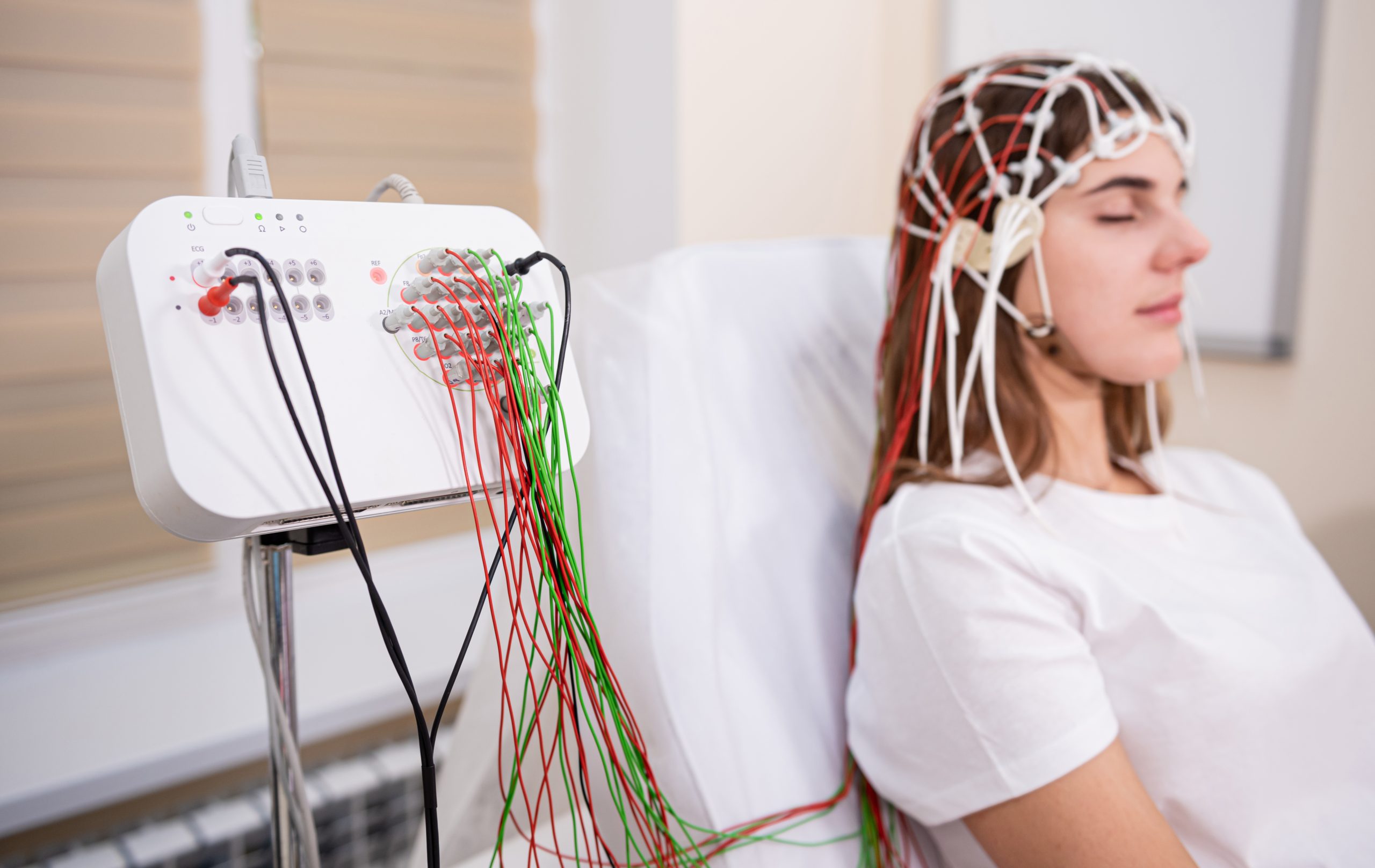Market Overview
The Australia EEG machines market is valued at approximately USD 16.16 million in 2024, drawing on comprehensive market research that identifies continuous advancements in healthcare technology and a growing prevalence of neurological disorders as primary drivers of market growth. The increasing incidence of epilepsy, sleep disorders, and other neurological conditions necessitates advanced diagnostic tools such as EEG machines, pushing hospitals and clinics to invest in sophisticated equipment.
Major cities such as Sydney, Melbourne, and Brisbane dominate the EEG machines market due to their robust healthcare infrastructure and concentration of specialized medical facilities. Sydney, in particular, benefits from being a hub for medical research and innovation, attracting leading health practitioners and facilitating collaborations with tech companies. Melbourne’s expansive healthcare network and established neurology departments further bolster its position, while Brisbane contributes to the growing demand through an increasing population focused on health advancement.
Australia’s aging population is a crucial driver of the EEG machines market. The Australian Bureau of Statistics reports that the proportion of individuals aged 65 and older is projected to increase from 16% in 2022 to 22% by 2035. This demographic shift leads to a higher prevalence of age-related neurological diseases like Alzheimer’s and Parkinson’s, necessitating the need for effective diagnostic tools.
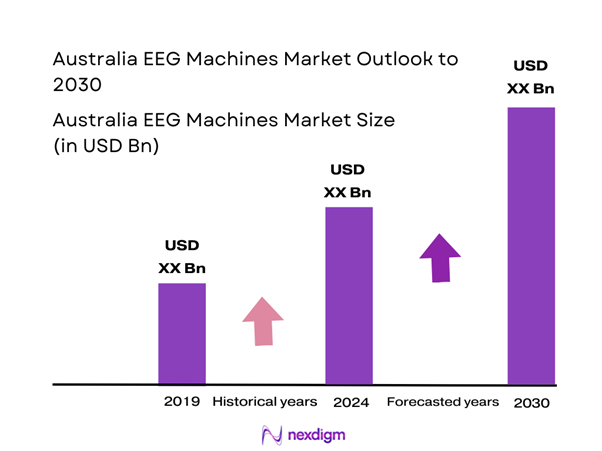
Market Segmentation
By Product Type
The Australia EEG machines market is segmented by product type into portable EEG machines, desktop EEG machines, wireless EEG machines, long-term EEG monitoring systems, and EEG caps and accessories. Among these, the portable EEG machines segment is experiencing significant growth due to their flexibility and convenience for use in diverse settings such as hospitals and outpatient facilities. The rise of telemedicine and the need for patient monitoring in remote areas are fueling the demand for portable devices that allow for effective management of patients’ neurological conditions outside traditional clinical settings.
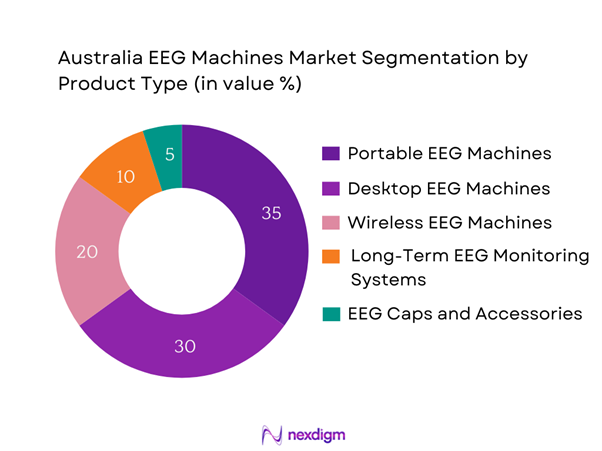
By Application
The market is also segmented by application into hospitals, neurology clinics, home care settings, research laboratories, and ambulatory services. Hospitals hold a dominant share in this segment due to their extensive resources and the increasing number of patients requiring EEG testing. Hospitals are equipped with the latest technology and highly trained medical staff, which enhances their capability to perform comprehensive EEG diagnostics. This concentration of expertise and equipment makes hospitals the primary choice for EEG applications, fostering significant growth in this sector.
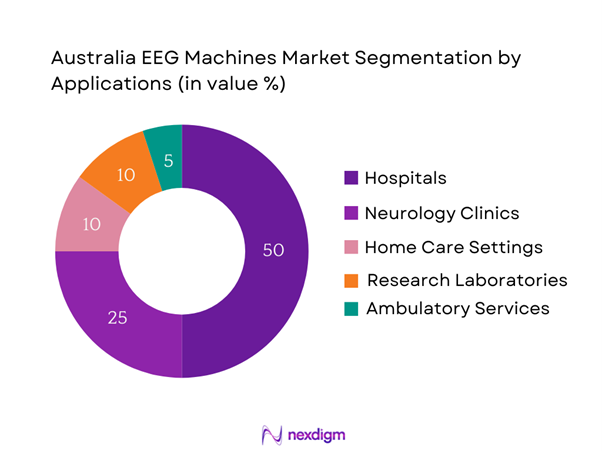
Competitive Landscape
The Australia EEG machines market is dominated by several key players, including Medtronic, Natus Medical Incorporated, Nihon Kohden, Compumedics, and Electrical Geodesics, Inc. This consolidation highlights a competitive landscape where these established companies leverage innovation and robust distribution networks to strengthen their market position. Their vast experience and product offerings help them meet varied client needs, ensuring that they can navigate the evolving demands of the healthcare sector efficiently.
| Company | Establishment Year | Headquarters | Market Focus | Product Offerings | Key Differentiator | Sales Channels |
| Medtronic | 1949 | Dublin, Ireland | – | – | – | – |
| Natus Medical Incorporated | 1989 | Pleasanton, USA | – | – | – | – |
| Nihon Kohden | 1951 | Tokyo, Japan | – | – | – | – |
| Compumedics | 1987 | Abbotsford, Australia | – | – | – | – |
| Electrical Geodesics, Inc. | 1998 | Eugene, USA | – | – | – | – |
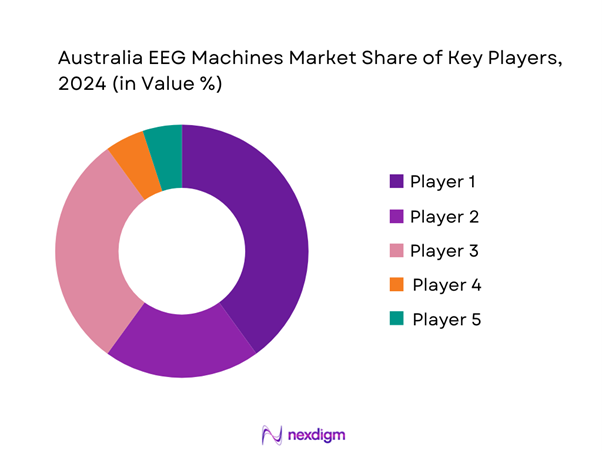
Australia EEG Machines Market Analysis
Growth Drivers
Increasing Incidence of Neurological Disorders
The incidence of neurological disorders is a significant growth driver for the EEG machines market in Australia. It is estimated that approximately 1 in 5 Australians experience a neurological condition at some point in their lives, with over 600,000 individuals currently diagnosed with epilepsy alone. Additionally, the Australian Institute of Health and Welfare indicates that the prevalence of dementia, primarily among older adults, is expected to reach 400,000 individuals by end of 2025. This increasing burden of neurological disorders drives demand for advanced diagnostic equipment such as EEG machines for early detection and management.
Advancements in EEG Technology
Technological innovations in EEG machines are fostering market growth by enhancing diagnostic capabilities and usability. New developments in portable EEG technology and wireless systems have expanded their applicability beyond traditional clinical environments to home monitoring. The introduction of advanced features like real-time data transmission and integration with mobile applications significantly improves patient compliance and outcomes. According to a report by the World Health Organization, over 30% of healthcare providers in Australia plan to adopt technology with integrated AI for better diagnostic precision, which further drives the demand for cutting-edge EEG devices.
Market Challenges
High Costs of EEG Equipment
Despite the growing demand for EEG machines, the high costs of these devices pose a significant challenge to market growth. The average price for advanced EEG systems can exceed AUD 50,000, which is often a substantial financial burden for smaller healthcare facilities and private practices. This price point may restrict accessibility and limit the adoption rate of EEG technology, especially in rural areas where funding for healthcare equipment can be limited. According to the Australian Medical Association, disparities in healthcare funding further exacerbate the challenges faced by hospitals in procuring necessary medical equipment.
Shortage of Trained Professionals
The shortage of trained healthcare professionals, particularly neurologists and EEG technicians, is a pressing challenge in the EEG machines market. A report from Health Workforce Australia highlights that by end of 2025, Australia will face a workforce shortfall of over 18,000 medical practitioners, which includes specialists capable of conducting EEG tests and interpreting their results. This lack of trained personnel can lead to delays in testing and diagnosis, ultimately impacting patient care and the effective utilization of EEG machines. Addressing this workforce gap is imperative for future market growth.
Opportunities
Rising Demand for Home Monitoring Systems
The increasing need for home monitoring systems presents a significant opportunity in the EEG machines market. With over 25% of Australians having reported using health-monitoring devices at home in a study published by the Australian Bureau of Statistics, there is a growing trend towards incorporating remote monitoring solutions into healthcare. This shift allows patients with neurological conditions to receive continuous monitoring, enhancing their quality of life while reducing the need for frequent hospital visits. Furthermore, the advent of telehealth services has made it easier for healthcare providers to monitor patients remotely, significantly increasing the demand for portable EEG systems that support such technologies. The current trajectory indicates a heightened interest in devices that can facilitate at-home diagnosis and treatment.
Technological Innovations in EEG
The rapid advancements in EEG technology offer substantial growth prospects for the market. Innovations such as mobile EEG devices equipped with cloud connectivity are transforming the monitoring of brain activity. For instance, a recent study indicated that the use of mobile EEG technology has led to improved diagnostic accuracy and better patient engagement, particularly among individuals with epilepsy. The incorporation of artificial intelligence and machine learning algorithms is expected to enhance data interpretation and facilitate the timely delivery of results, pushing EEG machines to the forefront of neurological diagnostics. As the healthcare sector continues to embrace these technological advancements, EEG machines stand to benefit significantly from this trend
Future Outlook
The Australia EEG machines market is anticipated to experience significant growth in the coming years, driven by ongoing technological advancements, increasing investments in healthcare infrastructure, and the rising prevalence of neurological disorders. The integration of artificial intelligence in EEG analysis and remote monitoring is expected to enhance diagnostic accuracy and operational efficiency. Furthermore, the growing awareness of mental health issues and the subsequent demand for diagnostic tools signal a promising market trajectory. Government initiatives also play a critical role in fostering innovation within the healthcare sector, leading to a positive outlook for EEG machine adoption across various healthcare settings.
Major Players
- Medtronic
- Natus Medical Incorporated
- Nihon Kohden
- Compumedics
- Electrical Geodesics, Inc.
- Philips Healthcare
- Siemens Healthineers
- GE Healthcare
- BrainScope Company, Inc.
- Toshiba Medical Systems
- Hitachi Medical Corporation
- NeuroSky
- Ceribell
- Omega Diagnostics
- Advanced Brain Monitoring
Key Target Audience
- Hospitals and Healthcare Providers
- Neurology Clinics
- Home Healthcare Agencies
- Medical Equipment Distributors
- Research Institutions
- Investments and Venture Capitalist Firms
- Government and Regulatory Bodies (Therapeutic Goods Administration)
- Health Insurance Companies
Research Methodology
Step 1: Identification of Key Variables
The initial phase involves creating a detailed ecosystem map that encompasses all significant stakeholders in the Australia EEG machines market. This process relies on extensive desk research, utilizing a combination of secondary and proprietary databases to gather thorough industry-level insights. The primary objective is to identify and define the critical variables that influence market dynamics, such as technological advancements and regulatory frameworks.
Step 2: Market Analysis and Construction
This phase focuses on compiling and analyzing historical data related to the Australia EEG machines market. It includes assessing market penetration, the ratio of medical facilities to the population, and the resultant revenue generation. Additionally, an evaluation of service quality statistics will be conducted to ensure the reliability and accuracy of the revenue estimates, which will inform market projections.
Step 3: Hypothesis Validation and Expert Consultation
Market hypotheses will be established and validated through computer-assisted telephone interviews (CATI) with industry experts representing a diverse range of organizations. These consultations will provide valuable operational and financial insights directly from practitioners in the field, crucial for refining and corroborating the market data.
Step 4: Research Synthesis and Final Output
The final phase entails direct engagement with major EEG machine manufacturers to acquire detailed insights into product segments, sales performance, consumer preferences, and other relevant factors. This interaction will serve to verify and supplement the statistics derived from the bottom-up approach, ensuring a comprehensive, accurate, and validated analysis of the Australia EEG machines market.
- Executive Summary
- Research Methodology
(Market Definitions and Assumptions, Abbreviations, Market Sizing Approach, Consolidated Research Approach, Understanding Market Potential Through In-Depth Industry Interviews, Primary Research Approach, Limitations and Future Conclusions)
- Definition and Scope
- Overview Genesis
- Timeline of Major Players
- Business Cycle
- Supply Chain and Value Chain Analysis
- Growth Drivers
Increasing Incidence of Neurological Disorders
Advancements in EEG Technology
Growing Geriatric Population - Market Challenges
High Costs of EEG Equipment
Shortage of Trained Professionals - Opportunities
Rising Demand for Home Monitoring Systems
Technological Innovations in EEG - Trends
Shift Towards Telemedicine
Integration of AI in EEG Analysis - Government Regulation
Medical Device Regulations
Compliance with Quality Standards - SWOT Analysis
- Stake Ecosystem
- Porter’s Five Forces
- By Value, 2019-2024
- By Volume, 2019-2024
- By Average Price, 2019-2024
- By Product Type (In Value %)
Portable EEG Machines
– Battery-operated Handheld EEG Units
– Compact 8–32 Channel Systems
– Wearable Portable EEGs for Home Use
Desktop EEG Machines
– Clinical-Grade Multichannel EEG Units
– EMR-Integrated Workstation EEG Systems
– High-Resolution Recording Units
Wireless EEG Machines
– Bluetooth-Enabled EEG Systems
– Wi-Fi Compatible Real-Time EEG Devices
– Wireless Ambulatory Monitoring Systems
Long-term EEG Monitoring Systems
– ICU-Based Long-Term Video EEG Systems
– Sleep Lab Monitoring EEG Equipment
– Epilepsy Monitoring Units (EMU)
EEG Caps and Accessories
– Disposable EEG Caps
– Reusable Electrode Caps
– Electrode Gels, Adhesives, Cables - By Application (In Value %)
Hospitals
– Public Hospitals
– Private Hospitals
– Specialized Neurology Wards
Neurology Clinics
– Standalone Neurology Diagnostic Centers
– Multi-specialty Clinics with Neuro Units
Home Care Settings
– Tele-EEG Kits for Remote Monitoring
– Portable Devices for Seizure Monitoring
Research Laboratories
– Neuroscience and Psychology Labs
– Cognitive Research Labs
– University-based Medical Research Units
Ambulatory Services
– Mobile EEG Units
– On-site Emergency Diagnostic EEG Services - By Distribution Channel (In Value %)
Direct Sales
– OEM-to-Hospital Sales
– Institutional Sales via Tenders
Medical Device Distributors
– National Distributors
– Regional Distributors across states
Online Sales
– OEM Online Stores
– Third-Party Marketplaces - By End-User (In Value %)
Adult Patients
– Epilepsy and Seizure Monitoring
– Sleep Studies and Brain Activity Diagnosis
Pediatric Patients
– Neonatal EEG Monitoring
– Pediatric Neurology & Developmental Delay Diagnostics - By Region (In Value %)
New South Wales
Victoria
Queensland
Western Australia
South Australia
- Market Share of Major Players on the Basis of Value/Volume, 2024
- Cross Comparison Parameters (Company Overview, Business Strategies, Recent Developments, Organizational Structure, Strengths and Weaknesses, Revenues, Revenues by Product Type, Number of Clinical Applications, Distribution Networks, Number of Health Institutions Served, Production Capacity, R&D Investment and Innovation Capabilities, Technology Integration, Regulatory Approvals & Certifications, Unique Value Offerings, Customer Support & After-Sales Service, Geographic Presence)
- SWOT Analysis of Major Players
- Pricing Analysis for Major Players
- Detailed Profiles of Major Companies
Medtronic
Natus Medical Incorporated
Nihon Kohden
Compumedics
Amplified Agility
Electrical Geodesics, Inc.
BrainScope Company, Inc.
Philips Healthcare
Beckman Coulter, Inc.
GE Healthcare
Siemens Healthineers
Abbott Laboratories
NeuroSky
Ceribell
Emergent BioSolutions
- Market Demand and Utilization
- Purchasing Power and Budget Allocations
- Regulatory and Compliance Requirements
- Needs, Desires, and Pain Point Analysis
- Decision-Making Process
- By Value, 2025-2030
- By Volume, 2025-2030
- By Average Price, 2025-2030

